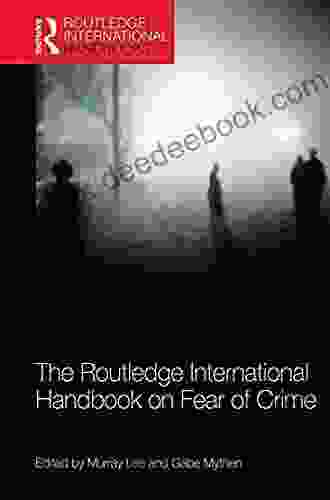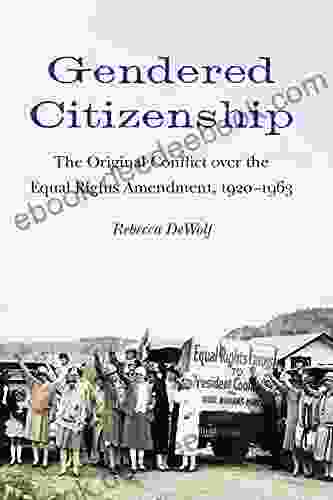The Original Conflict Over The Equal Rights Amendment: A Historical Perspective (1920-1963)

The Equal Rights Amendment (ERA) is a proposed amendment to the United States Constitution that seeks to guarantee equal rights for all citizens regardless of sex. The amendment has been a subject of intense debate and controversy since it was first introduced in 1920. In this article, we will explore the historical origins of the ERA, examining the key figures, arguments, and events that shaped its development from 1920 to 1963.
5 out of 5
| Language | : | English |
| File size | : | 1714 KB |
| Text-to-Speech | : | Enabled |
| Screen Reader | : | Supported |
| Enhanced typesetting | : | Enabled |
| Word Wise | : | Enabled |
| Print length | : | 345 pages |
| Lending | : | Enabled |
| Hardcover | : | 144 pages |
| Item Weight | : | 12.8 ounces |
| Dimensions | : | 6 x 0.38 x 9 inches |
The Origins of the ERA
The ERA has its roots in the women's suffrage movement of the late 19th and early 20th centuries. Suffragists argued that women deserved the same political rights as men, including the right to vote. After a decades-long campaign, the 19th Amendment to the Constitution was ratified in 1920, granting women the right to vote.
However, many women's rights activists believed that the 19th Amendment did not go far enough. They argued that women faced discrimination in many other areas of life, including employment, education, and family law. In 1923, Alice Paul, a prominent suffragist, founded the National Woman's Party (NWP) with the goal of securing a constitutional amendment that would guarantee equal rights for women.
The National Woman's Party and the Proposed ERA
The NWP drafted the Equal Rights Amendment in 1923. The amendment stated that "equality of rights under the law shall not be denied or abridged by the United States or by any State on account of sex." Paul and her supporters believed that the ERA would provide a powerful legal basis for challenging discrimination against women in all areas of life.
Opposition to the ERA
The NWP's proposal for an ERA quickly drew opposition from a variety of groups. Many traditionalists argued that the ERA would undermine the traditional roles of men and women in society. They feared that women would lose their rights to alimony and child support, and that fathers would lose their authority over their children.
Business groups also opposed the ERA, arguing that it would increase their costs and reduce their ability to compete in the global economy. They feared that the ERA would require them to pay women equal wages for equal work and provide them with equal opportunities for advancement.
The Phyllis Schlafly Era
In the 1960s, the opposition to the ERA was led by Phyllis Schlafly, a conservative activist and author. Schlafly argued that the ERA was a "radical feminist" plot to destroy the traditional family. She claimed that the ERA would allow women to avoid military service, would give them the right to abortion, and would lead to the breakdown of society.
Schlafly's message resonated with many Americans, particularly those who were concerned about the social changes that were taking place during the 1960s. She founded the Eagle Forum, a conservative women's group that became a powerful force in opposing the ERA.
The ERA in Congress
The ERA was first introduced in Congress in 1923, but it faced strong opposition from the beginning. The amendment was defeated multiple times over the years, despite the efforts of its supporters.
In 1972, Congress finally passed the ERA, and it was sent to the states for ratification. The amendment needed to be ratified by 38 states in order to become part of the Constitution.
The Failed Ratification Effort
The ratification process for the ERA was a long and difficult one. By 1979, 35 states had ratified the amendment, but it still needed three more states to become part of the Constitution. However, the anti-ERA movement, led by Schlafly and her supporters, was able to prevent the amendment from being ratified in the remaining states.
In 1982, the deadline for ratification passed, and the ERA failed to become part of the Constitution. The original conflict over the ERA had come to an end, but the debate over women's rights and equality continues to this day.
The original conflict over the Equal Rights Amendment from 1920 to 1963 was a complex and multifaceted issue. The amendment was supported by many women's rights activists who believed that it would guarantee equal rights for women in all areas of life. However, the amendment also faced strong opposition from traditionalists, business groups, and conservative activists who feared that it would undermine traditional values and the traditional roles of men and women in society. The ERA was ultimately defeated, but the debate over women's rights and equality continues to this day.
References
* Equal Rights Amendment (Encyclopedia Britannica) * The Equal Rights Amendment (History.com) * Equal Rights Amendment Timeline (National Women's History Museum)
5 out of 5
| Language | : | English |
| File size | : | 1714 KB |
| Text-to-Speech | : | Enabled |
| Screen Reader | : | Supported |
| Enhanced typesetting | : | Enabled |
| Word Wise | : | Enabled |
| Print length | : | 345 pages |
| Lending | : | Enabled |
| Hardcover | : | 144 pages |
| Item Weight | : | 12.8 ounces |
| Dimensions | : | 6 x 0.38 x 9 inches |
Do you want to contribute by writing guest posts on this blog?
Please contact us and send us a resume of previous articles that you have written.
 Book
Book Page
Page Story
Story Genre
Genre Paperback
Paperback Newspaper
Newspaper Paragraph
Paragraph Sentence
Sentence Bookmark
Bookmark Shelf
Shelf Glossary
Glossary Bibliography
Bibliography Foreword
Foreword Synopsis
Synopsis Annotation
Annotation Footnote
Footnote Scroll
Scroll Tome
Tome Autobiography
Autobiography Reference
Reference Dictionary
Dictionary Character
Character Resolution
Resolution Librarian
Librarian Catalog
Catalog Card Catalog
Card Catalog Stacks
Stacks Periodicals
Periodicals Research
Research Lending
Lending Reserve
Reserve Academic
Academic Journals
Journals Reading Room
Reading Room Rare Books
Rare Books Interlibrary
Interlibrary Literacy
Literacy Study Group
Study Group Thesis
Thesis Textbooks
Textbooks Jude Collins
Jude Collins Kathryn M Obenchain
Kathryn M Obenchain Dave Gelly
Dave Gelly Rupert Darwall
Rupert Darwall Jaci Rae
Jaci Rae David S Alkek
David S Alkek Phil Collins
Phil Collins Scott W Wolfe
Scott W Wolfe Chenell Parker
Chenell Parker J L Leslie
J L Leslie Jim Kjelgaard
Jim Kjelgaard Michele Paiva
Michele Paiva Jill Lepore
Jill Lepore Clyde M Creveling
Clyde M Creveling Ingrid Holtz
Ingrid Holtz Carol Burmeister
Carol Burmeister Ayca Arkilic
Ayca Arkilic Carolyn Harris
Carolyn Harris Erik Morse
Erik Morse Kim Schaefer
Kim Schaefer
Light bulbAdvertise smarter! Our strategic ad space ensures maximum exposure. Reserve your spot today!

 Ashton ReedThe Complete Guide to Managing Anger and Strategies to Keep Anger and Stress...
Ashton ReedThe Complete Guide to Managing Anger and Strategies to Keep Anger and Stress...
 Clark BellVariational Bayesian Learning Theory: A Comprehensive Exploration by Masashi...
Clark BellVariational Bayesian Learning Theory: A Comprehensive Exploration by Masashi...
 Ken SimmonsUnveiling the Dark and Twisted World of a Powerful Crime Thriller: A Deadly...
Ken SimmonsUnveiling the Dark and Twisted World of a Powerful Crime Thriller: A Deadly... Jessie CoxFollow ·4k
Jessie CoxFollow ·4k James JoyceFollow ·4.6k
James JoyceFollow ·4.6k Charles ReedFollow ·3.6k
Charles ReedFollow ·3.6k Travis FosterFollow ·18.9k
Travis FosterFollow ·18.9k Victor HugoFollow ·14.5k
Victor HugoFollow ·14.5k Herb SimmonsFollow ·13.6k
Herb SimmonsFollow ·13.6k Russell MitchellFollow ·10.3k
Russell MitchellFollow ·10.3k Isaias BlairFollow ·2.1k
Isaias BlairFollow ·2.1k

 E.E. Cummings
E.E. CummingsThe Routledge International Handbook on Fear of Crime
Fear of crime is a serious problem that can...

 Fletcher Mitchell
Fletcher MitchellThe Hunchback in Hellenistic and Roman Art: A...
The hunchback, or kyphosis, is a physical...

 Victor Turner
Victor TurnerA Comprehensive Guide to Needle Felting for Moms:...
Needle felting, a captivating craft...

 Joseph Foster
Joseph FosterWhere is Scandinavia?
Scandinavia is a region in...

 Leon Foster
Leon FosterNovel Shades of Magic: A Masterpiece of Magical...
An Enthralling...
5 out of 5
| Language | : | English |
| File size | : | 1714 KB |
| Text-to-Speech | : | Enabled |
| Screen Reader | : | Supported |
| Enhanced typesetting | : | Enabled |
| Word Wise | : | Enabled |
| Print length | : | 345 pages |
| Lending | : | Enabled |
| Hardcover | : | 144 pages |
| Item Weight | : | 12.8 ounces |
| Dimensions | : | 6 x 0.38 x 9 inches |







